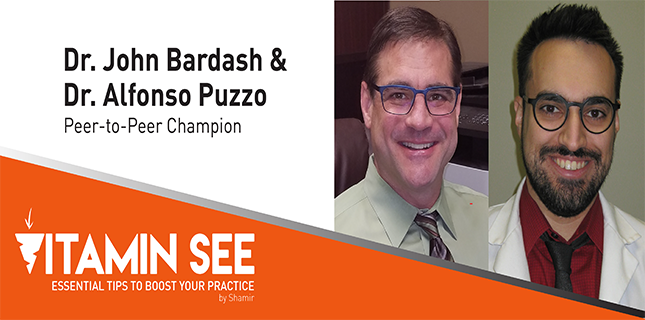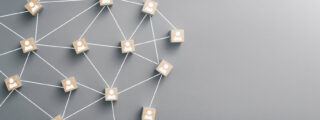
Blue light technology and computer users
We’re Drs. John Bardash and Alfonso Puzzo, and we practice optometry at Dr. Spex Vision Care in Denver, CO. Also joining us in this discussion of blue light protection is our general manager T.J. Rooks. Our topic: the increasing importance of blue light technology as it relates to computer use.
There’s a banner in our window of a man at a computer, so patients see the messaging before they even come inside. And once they see us, the conversation always includes blue light and its effects on the eyes.

THE MESSAGE
We tell patients that blue light coming from a computer inhibits the release of melatonin from their pituitary gland. We explain that can affect sleep quality. The conversation continues by discussing how the verdict is still out on what 50 years in front of the computer can do to the human eye. No one knows because it hasn’t been around that long yet.
We add that what we are already seeing is that blue violet and ultra violet can lead to macular degeneration. We add that’s why we are suggesting they use a blue-filtering coating like Shamir Blue Zero™, a lens treatment providing protection from the potential harm of natural and artificial light sources.

TECH TALK
There are plenty of patients in our practice who are in their 50s, 60s, and 70s, but because of the location–halfway between downtown Denver and the Denver Tech Center–a lot of younger tech-minded people are in the practice, too.
Many are the tech generation, in their 20s and 30s, including software engineers and developers. A lot of these younger patients are already aware of the dangers of blue light and have blue screens on their phones and monitors. We are definitely doing big business with providing these patients blue light filters with their eyewear.
THE CONVERSATION
Regardless of their age, it’s important to determine what their visual needs are, ask them what their job is, if they play computer games, etc. They may be using multiple monitors, and we try to find out how many hours a day they are using them.
It’s also important to ask what their actual hours of work are, because the practice has a lot of people who work in call centers at odd hours. Some people who work a little later into the night will definitely do better with a blue-blocking filter. Asking questions of this nature definitely helps get them the protection they need.
THE INTRO
We both wear the lenses and can actually demo them with our own glasses.
Our practice is set up so that each exam room has three monitors. Patients see that, and we can say, “See, I’m on computers all day. And, if I’m not in the exam room with a patient, I’m at my desk with another computer in front of me. The blue-light filter is important for us.”
SECOND PAIR
Depending on the patient, in addition to their general-use glasses, we may also discuss an office-specific pair that would be set, for example, at 26” as the working distance to their monitor.
We generally come out to the dispensary with the patient and mention to the optician that we discussed the filtering. I add that is because this patient spends a lot of time at a monitor and that a lighter, thinner frame like in titanium would also be good.
This is what we call the TURN…talking about the filtering a second time reiterates what’s been recommended and helps set up the sale.
LOOKING AHEAD
As computer and device users increase, which is becoming the way of the world, there is definitely going to be an increased demand for the blue light filtering. Already, awareness is rising, so demand is, too. Together, they will drive sales.
Comments are closed.








